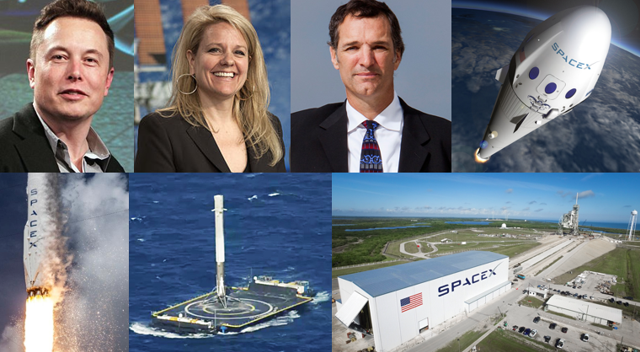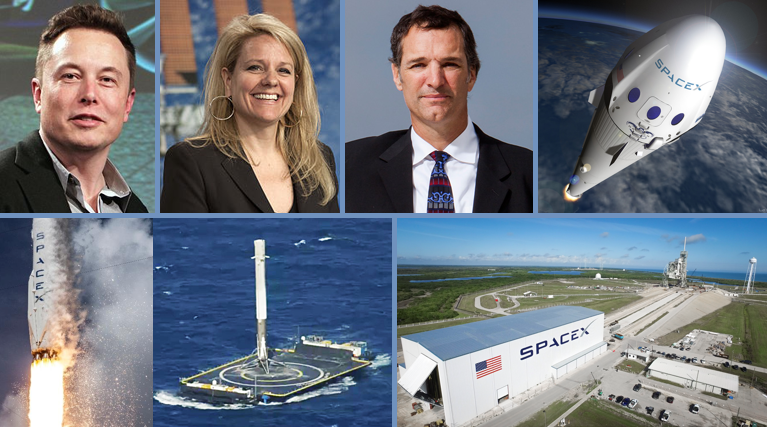
Unicorns 10/229 – SpaceX
Key people: Elon Musk (CEO and CTO), Gwynne Shotwell (President and COO), Tom Mueller (CTO of Propulsion)
Owner: Elon Musk Trust (54% equity; 78% voting control)
Space Exploration Technologies Corporation, better known as SpaceX, is an American aerospace manufacturer and space transport services company headquartered in Hawthorne, California. It was founded in 2002 by entrepreneur Elon Musk with the goal of reducing space transportation costs and enabling the colonization of Mars. SpaceX has since developed the Falcon launch vehicle family and the Dragon spacecraft family, which both currently deliver payloads into Earth orbit.
SpaceX’s achievements includ e the first privately funded liquid-propellant rocket to reach orbit (Falcon 1 in 2008); the first privately funded company to successfully launch, orbit, and recover a spacecraft (Dragon in 2010); the first private company to send a spacecraft to the International Space Station (Dragon in 2012); the first propulsive landing for an orbital rocket (Falcon 9 in 2015); and the first reuse of an orbital rocket (Falcon 9 in 2017). As of March 2017, SpaceX has since flown ten missions to the International Space Station (ISS) under a cargo resupply contract. NASA also awarded SpaceX a further development contract in 2011 to develop and demonstrate a human-rated Dragon, which would be used to transport astronauts to the ISS and return them safely to Earth.
SpaceX announced in 2011 that they were beginning a privately funded reusable launch system technology development program. In December 2015, a first stage was flown back to a landing pad near the launch site, where it successfully accomplished a propulsive vertical landing. This was the first such achievement by a rocket for orbital spaceflight. In April 2016, with the launch of CRS-8, SpaceX successfully vertically landed a first stage on an ocean drone-ship landing platform. In May 2016, in another first, SpaceX again landed a first stage, but during a significantly more energetic geostationary transfer orbit mission. In March 2017, SpaceX became the first to successfully re-launch and land the first stage of an orbital rocket.
In September 2016, CEO Elon Musk unveiled the mission architecture of the Interplanetary Transport System program, an ambitious privately funded initiative to develop spaceflight technology for use in manned interplanetary spaceflight, and which, if demand emerges, could lead to sustainable human settlements on Mars over the long term. This is the main purpose this System was designed for. In 2017, Elon Musk announced that the company had been contracted by two private individuals to send them in a Dragon spacecraft on a free return trajectory around the Moon. Provisionally launching in 2018, this could become the first instance of lunar tourism.
History
In 2001, Elon Musk conceptualized Mars Oasis, a project to land a miniature experimental greenhouse and grow plants on Mars, “so this would be the furthest that life’s ever traveled”[22] in an attempt to regain public interest in space exploration and increase the budget of NASA. Musk tried to buy cheap rockets from Russia but returned empty-handed after failing to find rockets for an affordable price.
Goals
Musk has stated that one of his goals is to improve the cost and reliability of access to space, ultimately by a factor of ten. The company plans in 2004 called for “development of a heavy lift product and even a super-heavy, if there is customer demand” with each size increase resulting in a significant decrease in cost per pound to orbit. CEO Elon Musk said: “I believe $500 per pound ($1,100/kg) or less is very achievable.”
Musk stated in a 2011 interview that he hopes to send humans to Mars’ surface within 10–20 years. In 2010, Musk’s calculations convinced him that the colonization of Mars was possible. In June 2013, Musk used the descriptor “Mars Colonial Transporter” (only later changed to “Interplanetary Transport System”; see below) to refer to the privately funded development project to design and build a spaceflight system of rocket engines, launch vehicles and space capsules to transport humans to Mars and return to Earth. In March 2014, COO Gwynne Shotwell said that once the Falcon Heavy and Dragon 2 crew version are flying, the focus for the company engineering team will be on developing the technology to support the transport infrastructure necessary for Mars missions.
Achievements
Landmark achievements of SpaceX includ e:
- The first privately funded liquid-fueled rocket to reach orbit (Falcon 1 Flight 4 — September 28, 2008)
- The first privately funded company to successfully launch, orbit, and recover a spacecraft (Falcon 9 Flight 2 — December 9, 2010)
- The first private company to send a spacecraft to the International Space Station (Falcon 9 Flight 3 — May 25, 2012)
- The first private company to send a satellite into geosynchronous orbit (Falcon 9 Flight 7 — December 3, 2013)
- The first landing of an orbital rocket’s first stage on land (Falcon 9 Flight 20 — December 22, 2015)
- The first landing of an orbital rocket’s first stage on an ocean platform (Falcon 9 Flight 23 — April 8, 2016)
- The first relaunch and landing of a used orbital rocket (Falcon 9 Flight 32 — March 30, 2017)
- The first controlled flyback and recovery of a payload fairing (Falcon 9 Flight 32 — March 30, 2017]
In December 2015, SpaceX launched an upgraded Falcon 9 rocket from Cape Canaveral Air Force Station into Low Earth orbit, on a mission designated Flight 20. After completing its primary burn, the first stage of the multistage rocket detached from the second stage as usual. The first stage then fired three of its engines to send it back to Cape Canaveral, where it achieved the world’s first successful landing of a rocket that was used for an orbital launch.
The upgraded Falcon 9 rocket is currently the only space launch system that uses densified propellants. SpaceX successfully re-introduced this technology with the aforementioned Flight 20. Before, propellant densification had been used only on some ICBMs, which are no longer in service, and the (unsuccessful) Soviet lunar rocket N1.

